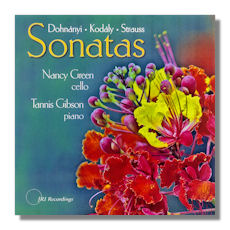
The Internet's Premier Classical Music Source
Related Links
-
Dohnányi Reviews
Kodály Reviews
R. Strauss Reviews - Latest Reviews
- More Reviews
-
By Composer
-
Collections
DVD & Blu-ray
Books
Concert Reviews
Articles/Interviews
Software
Audio
Search Amazon
Recommended Links
Site News
 CD Review
CD Review
Sonatas for Cello & Piano

- Ernő Dohnányi (1877-1960): Sonata in B Flat minor, Op. 8
- Zoltán Kodály (1882-1967): Sonata, Op. 4
- Richard Strauss (1864-1949): Sonata in F Major, Op. 6
Nancy Green, cello
Tannis Gibson, piano
JRI Recordings J123 TT:71:20
This presentation of very early works by three long-lived composers makes an appealing and coherent collection that could be a model for recital programs. The performances and recording quality leave nothing to be desired. The players are both strong and subtle; they play superbly together with appropriately varied tempi, clear articulation, vigorous attacks and full tone. As for the recording: with my eyes closed they might almost be playing in my living room.
After numerous hearings, the Kodály sonata promises to offer me the most lasting and pleasurable listening; I shall certainly return to it. It is in two movements only, Kodály having discarded not one but two opening movements by 1910. What remains is a beautiful work. The first movement is a short adagio, quiet, spare and ravishing, particularly in its piano part. The second begins with a vigorous and flowing allegro but yields to "molto adagio."
The earliest of these works was composed by Strauss in 1883 when he was 19. It has strong melodic appeal with effective thematic variation. The slow movement is lovely and the finale is both sweet and lively. The commentator, James Reel, notes influence by Mendelssohn and Schumann as well as the early development of the composer's own style.
Dohnányi is not a composer who has ever appealed to me personally and I wish the disc did not start off with a movement I confess to nodding off from occasionally. However, the scherzo which follows does maintain my attention with its extremely fleet pace varied by a slower central section. The short, songful adagio non troppo leads into a substantial theme and variations final movement which has interesting contrasts of character and rhythm, including a pizzicato section, some broad melody and some emphatic piano playing.
Recommended, especially for the Kodály.
Copyright © 2009, R. James Tobin




















